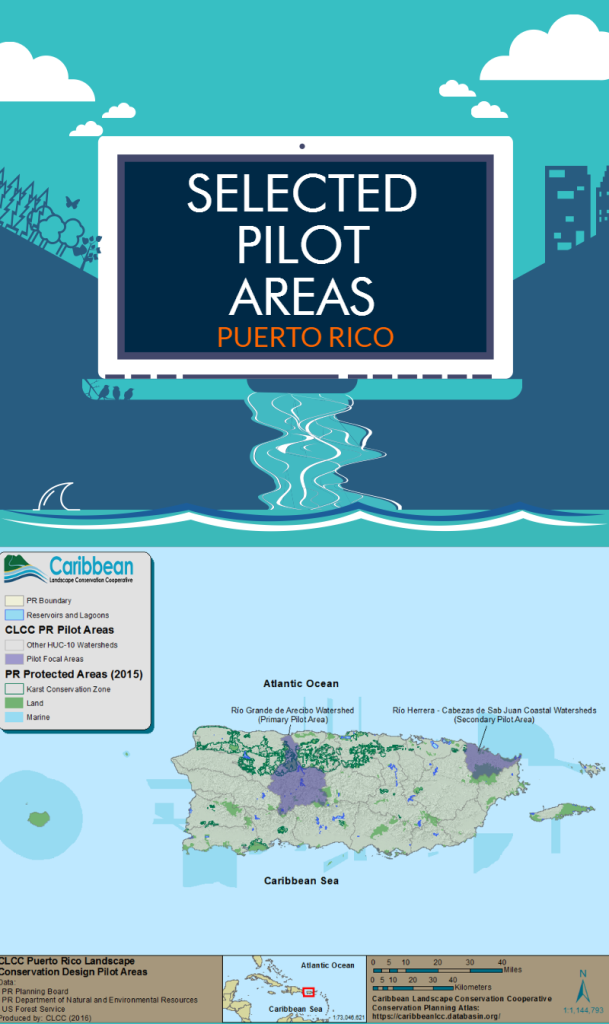Two Pilot Areas Selected in Puerto Rico and US Virgin Islands for Landscape Conservation Design
 By Brent Murry, CLCC Science Coordinator, US Fish and Wildlife Service
By Brent Murry, CLCC Science Coordinator, US Fish and Wildlife Service
The Steering Committee has focused the Cooperative’s attention on developing landscape conservation design (LCD) as a tool to facilitate collaborative, large landscape conservation and to help address multiple shared partner objectives (i.e. ecosystem integrity, human well-being, and preservation of cultural and historical resources). Recognizing that this level of collaborative conservation is not well-tested, the decision was made to select a pilot area to focus the Cooperative’s efforts. Focusing in a pilot area allows the Cooperative to focus resources and align partner investments and efforts with greater ease. By doing so, there is a greater probability of synergistic conservation outcomes and a better understanding of how to best approach collaborative conservation. A ‘ridge to reef’ model was adopted because the Cooperative understands and values ecosystem connectivity. To this end, watershed units (HUC-10) were selected as the base unit for pilot area selection in Puerto Rico.
A decision model using seven qualitative (expert opinion scores) and eight quantitative criteria was developed and weighted by participant values. The model was parameterized prior to the September 2016 Steering Committee meeting and the model was demonstrated and discussed. Through discussions revolving around the watershed specific attributes relative to the selection criteria, the Steering Committee selected two distinct pilot area regions, each with a different focus to not only improve conservation in Puerto Rico, but to also explore ways to proceed with collaborative conservation into the future.
The Rio Grande de Arecibo watershed was selected as the primary pilot area where the Cooperative will develop and implement LCD. The Rio Grande de Arecibo was selected largely due to its importance for providing water for human (and ecological) uses. In addition to the groundwater and surface water reservoir resources, the Rio Grande de Arecibo watershed is relatively highly forested with some agriculture in the uplands (e.g. the Bosque Modelo project is in this watershed and so exists the opportunity to coordinate). It is also within the expansion area identified critical for the recovery of the endangered Puerto Rican Parrot. Aquatic connectivity was also discussed as a top priority in this region. Finally, although most partners have interests in the region there are relatively few existing cross-agency plans that reach across all the partners in the region. The CLCC is empowered to explore the full capacity of the partnership to develop and implement long-term conservation strategies (e.g., LCD).
The Steering Committee also elected to adopt a secondary pilot area, the Rio Herrera to Las Cabezas de San Juan watersheds, essentially the larger Northeast Corridor region, where several partners, including NOAA, DRNA, Para La Naturaleza, and US Forest Service have significant endeavors underway. The intent of selecting this region is to explore the ways in which the Cooperative can interact and support other on-going landscape conservation partner-led initiatives. As opposed to leading conservation efforts as in the Rio Grande de Arecibo the idea in the Rio Herrera to Las Cabezas de San Juan watersheds will be to play a supplemental role. The Cooperative will try to bring new resources in support of existing efforts and/or identify gaps in existing efforts, especially relative to the priorities and objectives of the Cooperative that may or may not be being addressed by existing efforts. The NE Corridor region also differs tremendously from the Rio Grande de Arecibo in that it is more coastal focused and more densely populated.
These two pilot areas were selected because of their differences and what developing collaborative conservation under each scenario can teach us as we continue to forge ahead pioneering new approaches to large landscape collaborative conservation. Visit our website to learn more: why the Cooperative is using LCD and the detailed methodology for choosing the pilot areas.
The CLCC Staff and Steering Committee are currently in the process of selecting pilot area(s) in USVI.
